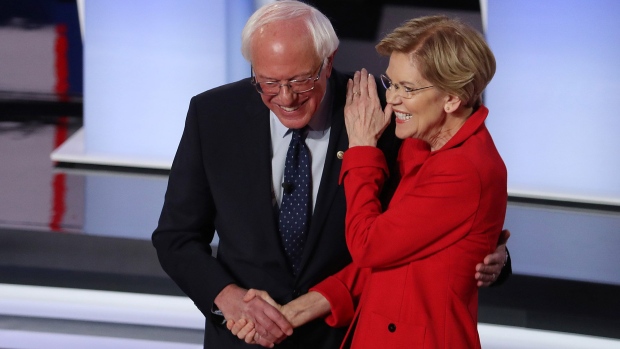Aug 18, 2019
Democrats Count on Re-Energizing Youth Vote for 2020 Elections
, Bloomberg News

(Bloomberg) -- The election prospects for Democrats in 2020 will turn on whether the party can keep fanning the fires that drove young voters to the ballot box last year.
A record jump in the turnout rate for young voters -- those ages 18 to 29 -- helped Democrats retake control of the House in the midterm elections. Several signs point to that voting trend continuing in 2020 with President Donald Trump on the ballot and the increasingly bitter political atmosphere driving up interest in the election among all voters.
“It is not crazy to think that youth turnout will be above 50% among people under 30 in 2020,” David Nickerson, a political science professor at Temple University. “If that ends up being right, then the Democrats are likely to gain a few votes.”
Although young voters typically cast ballots at rates well behind their elders, any increase could make a significant difference. And it’s not just the turnout -- it’s where those voters turn out. In five states, Minnesota, Wisconsin, Michigan, Pennsylvania and New Hampshire, the winning margin in the 2016 presidential election was 1.5 percentage points or less.
“If youth turnout jumps most in safely red states (e.g., Alabama) and blue states (e.g., California), then it won’t affect the outcome of the election,” Nickerson said in an email. “But if young people in swing states are sufficiently excited and inspired to vote in higher numbers, then they could play a pivotal role in the outcome.”
The advantage of a bigger youth vote likely would accrue to Democrats. Polls show young voters are increasingly aligned with the party on issues they regard as important. A Harvard Institute of Politics Public Opinion poll of young Americans in April found that 48% of young adults believe the nation is on the wrong track and 68% disapprove of Trump. A majority in the poll voted Democratic in the 2016 election and ranked among their top concerns promoting human rights, curbing gun violence and fighting climate change.
Democratic Coalition
“On issue after issue -- from climate change to gun violence -- Trump’s agenda is repulsive to younger voters and motivating them to hold him accountable. Democrats know younger voters will be a critical part of the coalition that helps us win,” said Maddie McComb, the Democratic National Committee’s spokeswoman.
The DNC has launched the the multi-million dollar Organizing Corps 2020, a program to recruit young people to work with them during the 2020 campaign cycle. Students in the program will be trained and sent into swing states in an effort to expand the youth electorate.
The Republican National Committee has launched a similar program, the Trump Victory Leadership Initiative, designed to train activists to go out and register young voters and organize their communities.
The liberal bent of young voters also is seen in the Democratic nomination race. Senators Elizabeth Warren and Bernie Sanders, who’ve framed their campaigns by progressive stands, each drew support from a quarter of Democratic voters 18-34, according to a Quinnipiac University poll released earlier this month. By comparison, front-runner Joe Biden has support from 15% of Democrats in that age group.
Issue Alignment
Sanders supports the Green New Deal, which sets an ambitious target of shifting the nation by 2030 to 100% “clean, renewable, and zero-emission energy sources” -- a high bar, given that fossil fuels (petroleum, natural gas and coal) accounted for 80% of U.S. energy consumption in 2018. Warren also backs the Green New Deal and released five policy proposals on climate change that emphasize the economic aspects of moving away from fossil fuels.
Warren has signed on as a co-sponsor of Sanders’ Medicare for All plan to replace private insurance with a government-run, single-payer system. Like most of the rest of the Democratic candidates, both support universal background checks for firearms purchases and re-instituting the ban on military-style assault rifles and high-capacity ammunition magazines.
Still, getting young voters to the polls remains a challenge for any candidate. In the last presidential election, voters 18-29 were the only age group to increase turnout compared with 2012. But less than half of young voters cast ballots -- 46% -- compared with more than two-thirds of those over age 45, according to U.S. Census figures.
Beyond party efforts, outside groups are stepping in with their own campaigns to motivate young voters. Many are centered on single issues, such as gun control and climate change.
Independent Groups
One of the oldest of such independent groups, Rock the Vote, says it has registered 61,841 people to vote this year, a 60% increase from this time during the last presidential election. Although the organization doesn’t advocate for a specific cause, it has seen a bump in registrations from young people as a result of building their campaigns around single issues.
“At moments of crisis, we often see young people reacting to tragedy with action, such as organizing and registering their peers to vote. It demonstrates young people’s committed being the change they seek and not waiting for older Americans to lead,” said Jen Tolentino, the group’s vice president of innovation and impact.
Researchers agree mobilization and participation from the youngest cohort in 2020 is crucial for Democrats, but many doubt single issue campaigns alone will turn the tide for youth voters.
Donald Green, a professor of political science at Columbia University, said driving voters to the polls is more dependent on emphasizing the importance of voting and the election as a whole.
“It is true that one thing that does follow from these incidents is a surge in interest in organizations or attending rallies,” Green said. “But young people are more likely to vote if they feel the election is important.”
To contact the reporter on this story: Jarrell Dillard in Washington at jdillard11@bloomberg.net
To contact the editors responsible for this story: Joe Sobczyk at jsobczyk@bloomberg.net, John Harney
©2019 Bloomberg L.P.


